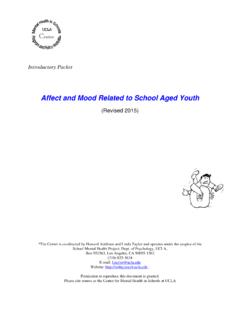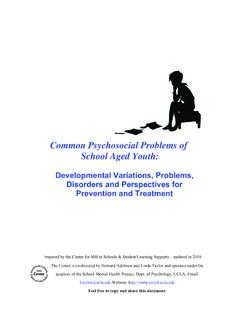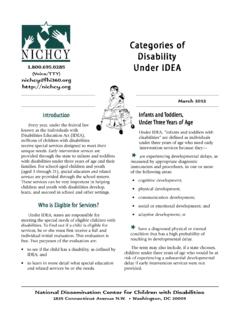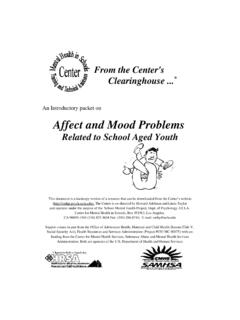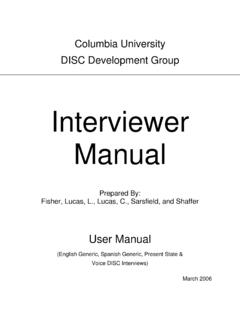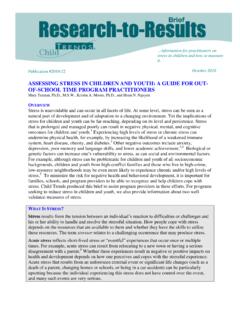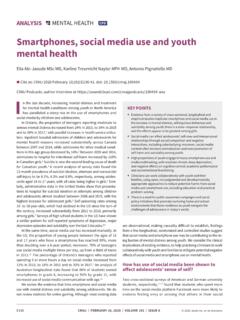Transcription of Guidelines for Serving Students with Emotional Disturbance ...
1 0 SPECIAL EDUCATION IN NORTH DAKOTA North Dakota Department of Public Instruction Kirsten Baesler, State Superintendent Office of Special Education 600 E. Boulevard Ave., Dept. 201 Bismarck ND 58505-0440 701-328-2277 (voice) 701-328-4920 (TDD) 701-328-4149 (Fax) Guidelines for Serving Students with Emotional Disturbance in Educational Settings United States Department of Education, Office of Special Education Programs (OSEP) 1 The Department of Public Instruction appreciates the time and effort spent by the task force members in contributing to the development of this guidance document. TASK FORCE MEMBERS Facilitators: Valerie Bakken and Bill Johnson Stacey Dailey Tim Eissinger Dr.
2 Lori Garnes Lisa Goldade Deb Keller Senator Joan Heckaman Tricia Lang Marcia Martin Vicki Peterson Jolene Schue Tamara Waters-Wheeler Jesse Krieger Special Note Unless otherwise specified, citations to section or sec. are citations to federal regulations implementing IDEA found in the Code of Federal Regulations at 34 CFR Part 300, which consists of 34 CFR secs. through and appendices A through E. NOTICE OF NON-DISCRIMINATION NORTH DAKOTA DEPARTMENT OF PUBLIC INSTRUCTION The Department of Public Instruction does not discriminate on the basis of race, color, national origin, sex, disability, or age in its programs and activities. For inquiries regarding nondiscrimination policies, please contact: Robert Marthaller, Director of school District Support Services, Department of Public Instruction, 600 E Boulevard Avenue, Dept 201, Bismarck, ND 58505-0440, 701-328-2267.
3 Equal education opportunity is a priority of the ND Department of Public Instruction. Publication Date: 9/26/2016 Cover artwork: Google Images - NHS West Kent 2 Table of Contents Section I. Introduction and Purpose of the Guidelines .. 5 Identification Rates vs. Prevalence Rates .. 5 Outcomes for Students with Emotional Disturbance .. 6 Section II: What is an Emotional Disturbance ? .. 6 Educational Definition of Emotional Disturbance .. 7 The Challenge of Identification: Defining the Criteria for Objective Application .. 8 Step 1: Has the student been exhibiting any of the five characteristics that define the condition? .. 9 Step 2: Has the student been exhibiting any of the five characteristics that define the condition for a long period of time and to a marked degree?
4 14 Step 3: Is the student s educational performance adversely affected? .. 14 Clinical Versus Educational Identification of Emotional Disturbance .. 17 Comorbidity and Emotional Disturbance .. 18 Challenges when Educating Students with Emotional Disturbance .. 18 Summary: What Is an Emotional Disturbance ?.. 19 Section III: Screening and Early Intervention .. 19 Purpose .. 19 Multi-Tier System of Support (MTSS) and Screening Efforts .. 20 Systematic Screening for Emotional and Behavioral 20 Summary: Screening, Early Intervention, and MTSS .. 23 Section IV. The Identification Process for Students Ages 3-21 .. 23 The Referral Process .. 23 Multidisciplinary Teams .. 24 Student Profile: Evaluation .. 24 Assessment Plan.
5 24 Evaluation Procedures .. 26 Evaluation tools: Full and Individual Evaluation .. 27 Checklist for a Full, Comprehensive, Individual Evaluation .. 28 The Eligibility Determination .. 29 Factors to Consider .. 29 Social/ Emotional Functioning .. 30 Exclusionary Clause .. 31 Adverse Effect on Educational Performance .. 31 Qualifying Elements .. 32 Summary: Evaluation and Eligibility .. 32 Section V. IEP Development .. 33 3 IEP Team .. 34 Parent/Guardian Participation .. 35 Present Levels of Academic and Functional Performance (PLAAFP) .. 36 Consideration of Special Factors .. 37 Measurable Annual Goals .. 38 Periodic Review of Services .. 39 Special Instructional Focus: Transition Planning .. 39 Adaptations of Educational Services.
6 41 Supplementary Aids and Services .. 41 Behavior Supports/FBA/BIP .. 41 Modifications and Accommodations .. 42 Summary IEP Development .. 42 Section VI. Placement in the Least Restrictive Environment (LRE) .. 43 The Placement Determination .. 44 LRE Justification .. 45 Section VII. Evidence-Based Prevention and Intervention Strategies .. 45 Core Features of Classroom Interventions and Supports .. 46 Map of Core Features .. 47 Improving Academic Achievement .. 48 Comprehensive Program of Intervention .. 49 Environment .. 49 Behavior Management .. 50 Continuum of Behavior Management Strategies .. 53 Academic or Learning Strategies .. 54 Affective Education Strategies .. 55 Counseling/Therapy 55 Summary: Evidence-Based Prevention and Intervention Strategies.
7 56 Section VIII: Resources for Educating Students with Emotional Disturbance .. 56 North Dakota Resources .. 56 National Resources .. 58 Resources for Educators .. 58 Links to Additional Resource Documents .. 59 Section IX. References .. 61 Section X. List of 64 Appendix A: Systematic Screening Tools for Early 64 4 Appendix B: Prevent Teach Reinforce (PTR) Functional Behavioral Assessments (FBA) and Behavior Intervention Plans (BIP) Resources .. 64 Appendix C: ABC Data Collection Sheet .. 64 Appendix D: Scatterplot Assessment Tool .. 64 Appendix E: Student Risk Screening Scale (SRSS) and Student Internalizing Behavior Screening Scale (SIBSS) .. 64 Appendix F: Standardized Assessments of Behavior.
8 64 Appendix G: Eligibility Determination 64 Appendix H: High Yield Instructional Strategies (Marzano, 2001) .. 64 Appendix I: Functional Behavioral Assessments & Positive Behavior Intervention Plans Guide .. 64 Systematic Screening Tools for Early Intervention .. 65 Prevent Teach Reinforce (PTR) .. 66 Functional Behavior Assessment and Behavior Intervention Plans Resources66 ABC Data Collection Sheet .. 67 Scatter Plot Assessment Tool .. 68 Student Risk Screening Scale (SRSS) .. 69 Student Internalizing Behavior Screening Scale (SIBSS) .. 69 Standardized Assessments of Behavior .. 70 Determination of Eligibility: Emotional Disturbance .. 71 Marzano s (Nine) High-Yield Instructional Strategies .. 73 Functional Behavioral Assessments & Positive Behavior Intervention Plans Guide.
9 76 5 Section I. Introduction and Purpose of the Guidelines The number of Students identified under IDEA with an Emotional Disturbance (ED) has remained remarkably stable over the last 30 years. During this time, approximately 1% of the school -aged population has been identified as disabled under the criteria set forth in IDEA (Kim, Forness, & Walker, 2012). When looking at all Students served in special education under IDEA, Students with ED comprise roughly 6% of the total population. From approximately 2003 2012, the trend in identification actually showed a decrease in the number of Students identified as having ED (National Center for Educational Statistics, 2015). If this is true, why do schools feel increasing pressure to effectively address Students Emotional and behavioral needs?
10 In North Dakota, the December 2015 Child Count revealed that 6% of all Students identified as having a disability under IDEA were found to be eligible under the category of Emotional Disturbance . The trend in North Dakota has shown a slight increase in the number of Students identified with ED in recent years, but overall this population has remained stable. Identification Rates vs. Prevalence Rates Identification rates, such as the 6% of all Students with disabilities in North Dakota who are identified as having an Emotional Disturbance under IDEA on the 2015 Child Count, excludes many Students who experience an Emotional or behavioral disorder. Many of these Students exhibit challenging behaviors; however, they have yet to meet the threshold of eligibility under IDEA as a student with ED.










